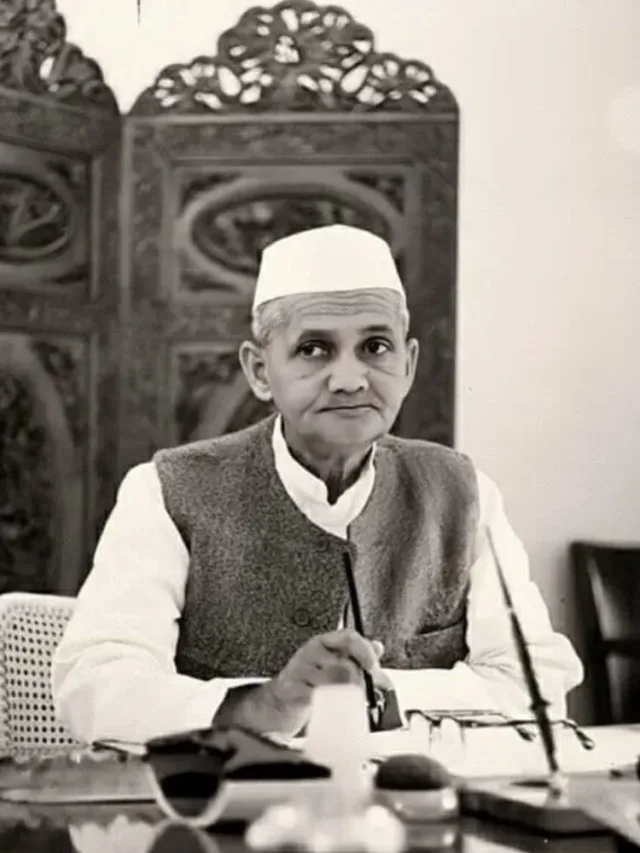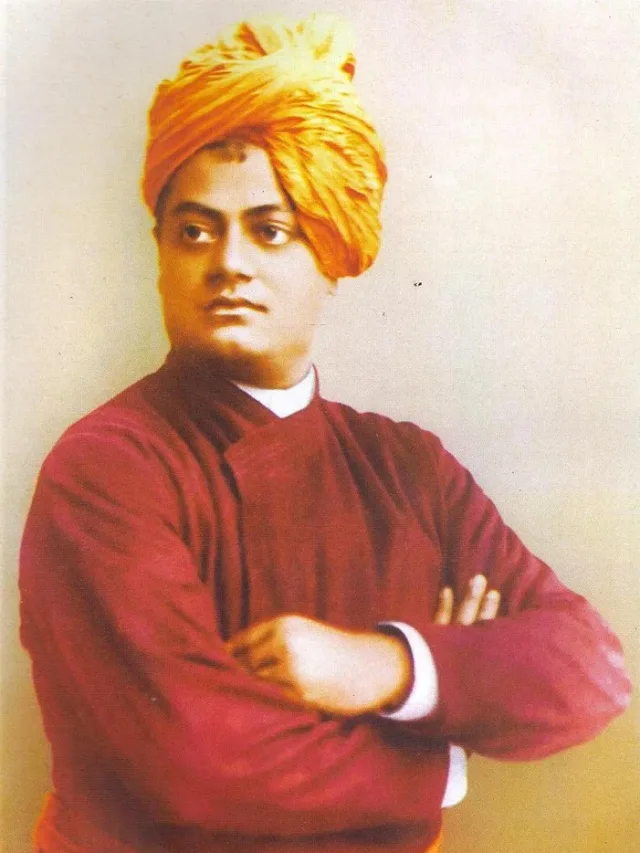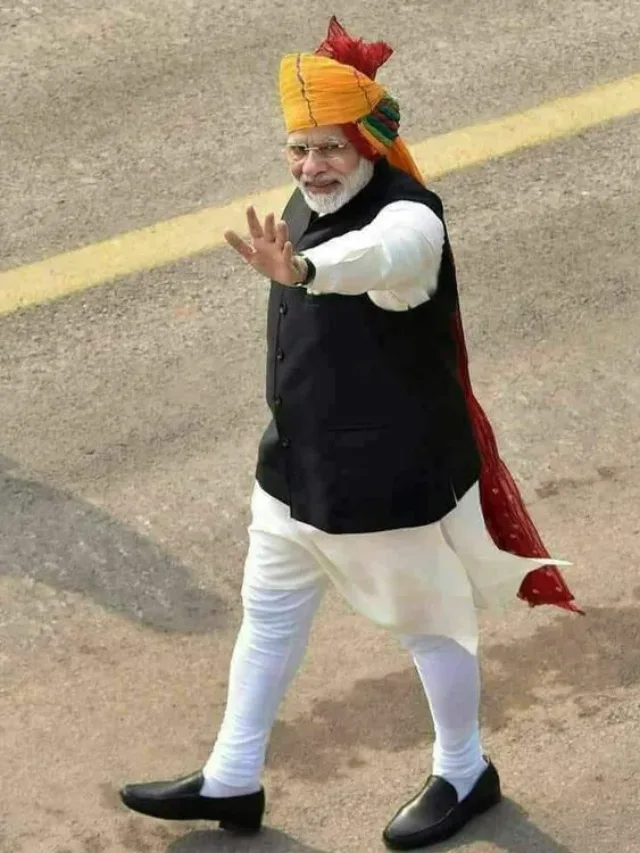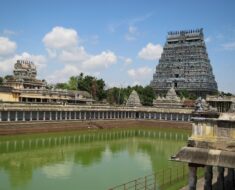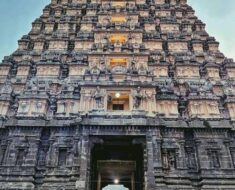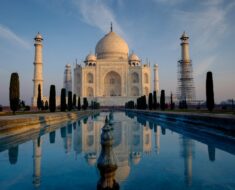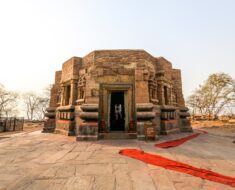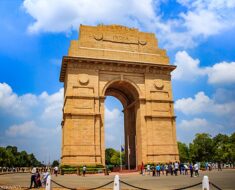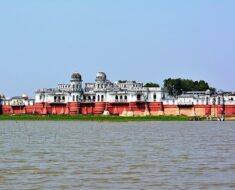The Statue of Unity, the world’s tallest statue was unveiled by Prime Minister of India, Narendra Modi on October 31, 2018.
Standing at a height of 597 feet (182 metres), the Statue of Unity depicts Sardar Vallabhbhai Patel, an Indian freedom fighter, and social and political leader.
He was an iconic leader and first deputy prime minister and the home minister of independent India.
This Sardar Patel statue will be a centre of attraction for tourists from around the world. People who visit should know that India is home to such legendary men. They should see our height. We want that they should measure the height of our nation. And when this statue of unity will be built, for us countrymen, it will be a pilgrimage of inspiration. – PM Narendra Modi
Here is a detailed list of incredible and interesting facts about the Statue of Unity – the world’s tallest statue.
Fact 1. What does the Statue of Unity Symbolize?
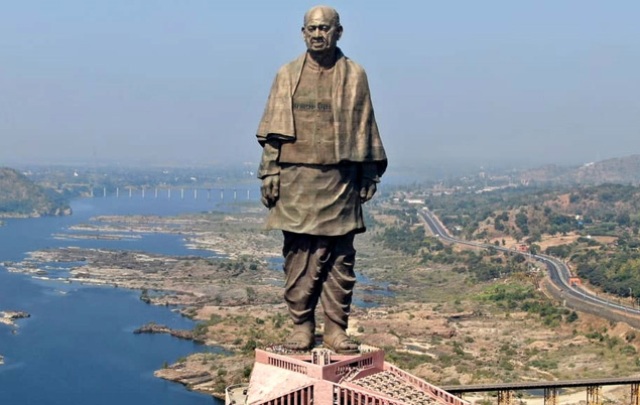
The Statue of Unity is a homage to the “Iron Man of India” Sardar Vallabh Bhai Patel. It is a patriotic symbol of his legacy, a man who devoted his whole life to the struggle for independence.
The statue is a tribute to his life, a role model of unity and statesmanship. It will inspire the generations to come and showcase his vision of unity, patriotism, inclusive growth and good governance.
The statue is not only a tribute to the Iron Man of India but also is the first such tourist attraction located in India and is termed ‘Pride of Nation’
A sense of patriotism and united India is infused within the hearts of the people who visit the Statue of Unity or even have a glimpse of it.
Read More: Largest Longest Highest in India – All Superlatives of India
Fact 2. Importance of the Statue of Unity
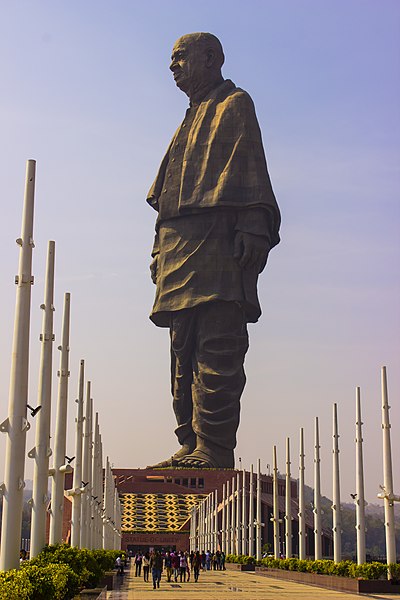
The world’s tallest statue – the Statue of Unity is not only a monument dedicated to Sardar Patel but it is designed and planned in such a way that it has proved to be a stimulant for the development and upliftment of the tribal population in the area around the Sardar Sarovar Dam.
Along with the statue, many other projects are also being undertaken. Livelihood generation, employment generation, social infrastructure, environment protection and tribal development are the main themes and pillars of this mega project.
Top-quality tourist facilities, excellent transport infrastructure with good connectivity, healthcare and education infrastructure and various tribal development initiatives are part of the project which will create employment opportunities directly or indirectly for thousands of people in Narmada District and nearby areas.
The Statue of Unity has boosted the tourism and hospitality sector with a large number of hotels, transport and other facilities coming up around the area.
This has helped in generating huge income and jobs from tourism, transportation and other services.
The government is adding several additional attractions, such as Butterfly Park, Jungle Safari Park, Children Nutrition Park, Digital Forest World, Cactus Garden and the recently-started 5-km river rafting ride, to woo tourists.
The statue is fast becoming one of the country’s top tourist attractions.
Fact 3. Location of the World’s Tallest Statue

The world’s tallest statue is located in a very picturesque location and has a spectacular panoramic view. Just 3.2 kilometres away from Sardar Sarovar Dam, the massive statue stands on the small island of Sadhu-Bet in the Narmada river, at Kevadia near Rajpipla City, district Narmada, in the Indian state of Gujarat.
The statue has a backdrop of majestic Vindhyachal and Satpuda Mountain Ranges. This monument has many other attractive tourist spots in its proximity such as the Valley of Flowers, the Shoolpaneshwar Sanctuary and sacred temple, the Sardar Sarovar Dam and its water dykes, the scenic Zarvani Falls and the majestic palaces of Rajpipla.
The statue’s surroundings occupy more than 2 hectares (4.9 acres) area. It is surrounded by a 12 sq km artificial lake.
💡 Read More: 15 Must-Visit Historical Places in India
Fact 4. Sardar Patel

Vallabhbhai Jhaverbhai Patel popularly known as Sardar Patel. He was one of the six children of Jhaverbhai Patel and Ladba was born in Nadiad, Gujarat. His date of birth was never recorded officially; he entered it as 31 October 1875 on his matriculation examination papers.
Sardar Patel was an Indian barrister and a senior leader of the Indian National Congress. Post-independence of India, he served as the First Deputy Prime Minister and Home Minister of India.
He played a leading role in the struggle for independence and was the founding father of the Republic of India and guided its integration into a united, independent nation.
Sardar Patel integrated 562 princely states into the Republic of India through diplomacy and negotiations and without any bloodshed. His efforts to unite a scattered nation is one of his greatest legacies and shows his power of persuasion and statesmanship.
4.1 Why is Vallbhbhai Patel called Sardar?
Women of Bardoli bestowed the title Sardar to Vallebhai Patel, which in Gujarati and most Indian languages means Chief or Leader.
In 1918, he led the ‘No Tax Campaign’ and urged the farmers not to pay taxes after the British imposed heavy taxes after the floods in Kaira.
In April 1928, the Bardoli area in Gujarat suffered from a serious famine and again farmers were forced to pay massive tax hikes the government seized their lands in retaliation when farmers were unable to pay the heavy taxes.
Many sympathy satyagrahas were undertaken across Gujarat. Despite arrests and seizures of property and land, the struggle intensified.
After negotiations by Patel, the lands were returned to the farmers, and the tax hike was taken back, village officials who had resigned in the protest were also reinstated.
Read More: Sarojini Naidu – ‘The Nightingale of India’
Fact 5. Architecture

The Statue of Unity is designed by 93-year-old Padma Bhushan awardee sculptor Ram V Sutar. He is India’s most admired and acclaimed sculptor.
His works include the restoration of sculptures found in Ajanta and Ellora, the Chambal monument at Gandhi Sagar Dam in Madhya Pradesh, the statue of Maharaja Ranjit Singh in Amritsar, the statue of Rabinder Nath Tagore and numerous statues of Mahatma Gandhi.
The Government of Gujarat had assigned the task of constructing the Statue of Unity to the “Sardar Vallabhbhai Patel Rashtriya Ekta Trust” (SVPRET), chaired by the Hon’ble Chief Minister of Gujarat. SVPRET executed the project through Sardar Sarovar Narmada Nigam Limited (SSNNL).
SSNNL management team & its engineers have built one of the tallest concrete gravity dams in the world and an irrigation system.
SVPRET had appointed Turner Project Management India Private Limited, Meinhardt India Private Limited and Michael Graves & Associates Inc., as Project Management Consultants. Many of the members of consultancy firms have been involved in developing some of the world’s tallest structures, including the Burj Khalifa in Dubai.
Larsen & Toubro was assigned the responsibility for designing, engineering, procurement, construction, operation and maintenance of the project.
Malaysia-based Eversendai was handed the contract for the steel framework. This company constructed Dubai’s famous Burj Al Arab and Burj Khalifa buildings.
The bronze cladding of the statue has been done by China’s Jiangxi Toqine Company (JTQ)
Accenture provides a digital media outreach programme.
Fact 6. Construction

For the construction of such a colossal national monument, a nationwide ‘Loha Campaign’ was conducted during the year 2013-14. In this campaign, farmers were asked to donate their used farming tools.
As a result of the Loha Campaign, 134.25 metric tonnes of iron was received from villages across the nation. Soil samples were also collected from farmers across the country as their voluntary contribution to the iconic project.
These iron tools were converted into reinforcement bars weighing 109.17 metric tonnes and used in the construction of the project. Soil collected from various parts of the country was used to make the symbolic Wall of Unity.
70,000 metric tonnes of cement, 18,500 metric tonnes of reinforcement bars and 6,000 metric tonnes of structural steel were used for the construction of the National Monument.
The surface area of about 22,500 square metres has been clad with around 1,700 metric tonnes of bronze. 12,000 bronze panels were used to cover the structure.
It took about 250 engineers and 3,400 labourers to construct the statue.
Read More: Golden Temple, Amritsar – Four Doors To Heaven
Fact 7. Statue of Unity – Cost
The Statue of Unity was built on a Public-private partnership (PPP) funding model. The total cost of the building was Rs 2,989 crores. Most of the money was raised by the Government of Gujarat.
- The Government of Gujarat had allotted ₹100 crores for the project in the budget for 2012-13 and ₹500 crores in 2014-15.
- In the 2014-15 Union Budget, ₹2 billion (US$28 million) was allocated for the construction of the statue.
Larsen & Toubro won the contract on 27 October 2014 for its lowest bid of ₹2,989 crores (US$420 million) for the design, construction and maintenance. They commenced the construction on 31 October 2014.
In the first phase of ₹2,989 crore (US$420 million) project, ₹1347 crore is for the main statue, ₹235 crore for the exhibition hall and convention centre, ₹83 crores for the bridge connecting the memorial to the mainland and ₹657 crores for the maintenance of the structure for 15 years after its completion.
Fact 8. Statue of Unity – Revenue
Since the opening of the Statue of Unity for the general public from November 2018 to July 2019, the cumulative revenue earned is around Rs 52.9 Cr. The RTI has provided a monthly average figure of Rs 6 Cr including goods and service tax (GST). Additionally a revenue of Rs 10 lakhs from parking.

At the current pace of revenue, the Statue of Unity would need around 42 years to break even given its known cost of approximately ₹3,000 crores.
Throughout of last 9-months, 19.4 lakhs visitors have visited the national monument. The statue has been operational for 232 days since its inauguration and the overall average daily footfall for this period is around 8347.
All these calculations are made given with respect to entry tickets only. No other revenue source is taken into consideration
Fact 9. Comparison of Heights
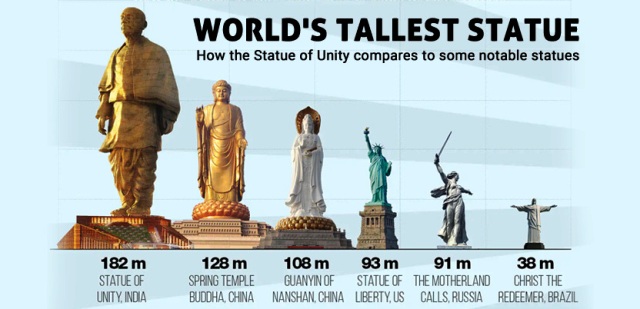
The height of the statue of unity surpasses the Spring Temple Buddha in Henan, China, which, at 153 metres (502 ft) was previously the tallest statue in the world.
The Statue of Unity is about four times the height of the Statue of Liberty. The height of the Statue of Liberty is about 152 feet from the base to the tip of the torch and the height of the Statue of Unity is 182 Metres (597 ft)
Apart from being the world’s tallest statue, it also holds the distinction of being among the fastest to be completed in just 46 months. China’s Spring Temple Buddha took 11 years to complete.
Fact 10. Statue of Unity – Controversies
- The government of India released Rs. 200 crores in the union budget 2014-15 for the project and this expenditure was criticised by several people and political parties.
- The work of bronze cladding of the statue was given to TQ Art Foundry – a subsidiary of the Jiangxi Toqine Company based in China by L&T. This move was overhyped and criticised by the Indian National Congress and other opposition parties. However, only 9 per cent of the total value of the project was sourced from China.
- The Tadvi tribe opposed the acquisition of land for the development of tourism infrastructure around the statue. However, they were provided jobs, cash and land compensation before the land acquisition.
- People of Kevadia, Kothi, Waghodia, Limbdi, Navagam, and Gora villages opposed the construction of the statue and demanded the restitution of the land rights over 375 hectares (927 acres) of land acquired earlier for the dam.
- Many activists like Medha Patkar, and Gladson Dungdung opposed the project saying that the place is of religious importance to tribals and that the statue should not be built on the land.
- Environmental activists from around the country wrote to the Union Environment Ministry that mandatory environment NOCs were taken for this massive project and the work began without any social or environmental impact assessment.
Read More: Top 10 Most Visited Monuments in India 2023
Some More Amazing Facts and Figures about the Statue of Unity
- The Statue of Unity project was first announced on 7 October 2010. On 31 October 2013, Statue’s Foundation stone was laid by Narendra Modi, the then-serving Chief Minister of Gujarat to mark the 138th birth anniversary of Sardar Vallabhbhai Patel.
- ‘Run For Unity’ a marathon was held on 15 December 2013, the 63rd death anniversary of Sardar Patel in several places throughout India
- Suraaj petition (“good governance”) was organized, wherein people can write their ideas about good governance. It was signed by around 20 million people and was termed the world’s largest petition.
- The Statue of Unity was built in just 46 months.
- In the first 11 days of its opening, over 1,28,000 tourists visited the site
- The innermost layer of the three-layered structure is made of reinforced cement concrete (RCC), steel and 8 mm bronze.
- The Statue of Unity will turn from its original bronze colour to green in 100 years due to a natural ageing process. The Statue of Liberty was originally dull brown and turned green in about 30 years due to oxidation
- The Statue of Unity is capable of withstanding wind velocity up to 50 metres/second (180 kilometres/hour speeds) and vibration.
- The statue has been designed for seismic Zone IV as an earthquake-resistant structure.
- The height of the toe of the Statue of Unity measures 3.6 metres.
- The diameter of the button on the vest of the Statue is 1.1 metres.
- The thickness of the bronze cladding on the Statue is 8 mm.
- The Statue of Unity has a viewing gallery at 135 metres, which can accommodate up to 200 visitors at a time and offers an extensive view of the surrounding beautiful mountain ranges of Satpuda and Vindhyachal, the 214 kilometres long Sardar Sarovar Reservoir and the 12 kilometres-long Garudeshwar Reservoir.
- The statue is made up of a three-layered structure. The innermost layer is made of reinforced cement concrete (RCC), comprising two towers 127 metres high that rise until the statue’s chest. The second layer is a steel structure and the third is an 8 mm bronze cladding on the surface.
- The RCC towers, which at the bottom form Patel’s dhoti-clad legs, have two lifts each. Each lift can carry 26 people to the top in just half a minute.
- There are moving walkways for the disabled and senior citizens. A museum and a sound and light show depicting the life and times of Sardar Patel are also in the complex
- A selfie point has been designated a few meters from the statue.
- A 52-room three-star hotel and two tent cities with 250 tents are there to accommodate the visitors to the site.
- The statue is estimated to remain as it is for 1000 years. It implies that it will continue contributing to the national income of India through tourism for 10 centuries.
- Entry ticket for adults is priced at Rs 120 while for children (between three to 15 years), it is Rs 60. The ticket includes entry to the ‘Valley of Flower’, memorial, museum and audio-visual gallery, SOU site and the Sardar Sarovar Dam. For the observation deck view, the ticket is priced at Rs 350. Tickets can be booked online at www.soutickets.in


